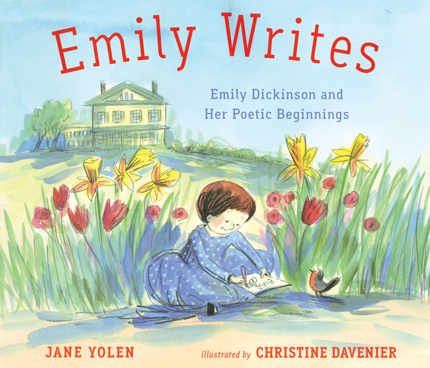| Emily writes : Emily Dickinson and her poetic beginnings Author: Yolen, Jane | ||
| Price: $6.50 | ||
Summary:
In Amherst, Massachusetts, in spring, 1834, young Emily Dickinson uses scraps of paper and a pencil nub to write a poem, before she even knows her ABCs, and shares it with her household and garden. Includes author's note about Dickinson's life and work.
| Illustrator: | Davenier, Christine |
Reviews:
Kirkus Reviews (01/01/20)
School Library Journal (02/01/20)
Booklist (02/01/20)
The Bulletin of the Center for Children's Books (+) (00/03/20)
The Hornbook (00/05/20)
Full Text Reviews:
School Library Journal - 02/01/2020 Gr 1–6—Incorporating bits from Emily Dickinson's poetry and what is known of her adult life, Yolen imagines an afternoon with four-year-old Emily. Slipping into her father's study, young Emily "discovers a scrap of paper under father's desk, some chance slip." (Adult Emily refers to her odds and ends of used writing paper as "chance slips.") This is a cheerful, deeply thoughtful child. "Perhaps, she thinks, I will make a poem." And so she does. Emily tries to tell her rhyming three-word bit—"frog and bog"—to her inattentive father and then her fretful mother, and finally succeeds down in the kitchen with friendly Mrs. Mack. (Readers learn more about Mrs. Mack in the author's note.) Once these two share laughter and a bit of cake, Emily goes out to the garden where her story becomes more complex and romanticized: "…she has not told her poem to the flowers yet…the garden makes her feel all sunny, like a poet…She thinks about the real and the unreal. Perhaps poems are the in-between." Emily goes on to find an envelope and consults Mrs. Mack about a word to rhyme with envelope. Yolen's cleverly constructed scheme will intrigue adult Dickinson fans. French illustrator Davenier's multimedia sketches provide simple, deft views of characters and settings. Yolen's substantial author's note tells much about Emily Dickinson and excerpts poems. A bibliography of adult and scholarly sources includes a few titles accessible to children. VERDICT Some parents might share this with children learning to read and write. It could also spark good discussion with older students studying Dickinson in poetry units.—Margaret Bush, Simmons College, Boston - Copyright 2020 Publishers Weekly, Library Journal and/or School Library Journal used with permission.
Booklist - 02/01/2020 In 1834, little Emily Dickinson tiptoes into her father's study, where he is working at his desk. Finding slips of discarded paper and a pencil stub on the floor, she scribbles a “poem” that only she can read. Though Father is too busy to look at it, she finds a more supportive audience in the kitchen. Mrs. Mack appreciates her rhyme, “Frog and bog,” and they enjoy a laugh together, along with leftover cake. Finding Mother and baby Lavinia too sleepy to listen to verse, Emily amuses herself in the garden for a while before returning to the kitchen, where she shares a doughnut and more possible rhymes with Mrs. Mack. Evidently based on inference rather than actual incidents, the story reflects Yolen’s love of language and her knowledge of the poet’s life and work as well as her understanding of young children. Davenier’s buoyant illustrations, soft line drawings brightened with colorful inks, portray the young Dickinson, her home, and the garden with spontaneity and warmth. An imaginative portrayal of the poet as a young child. - Copyright 2020 Booklist.



